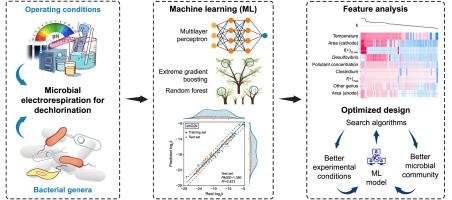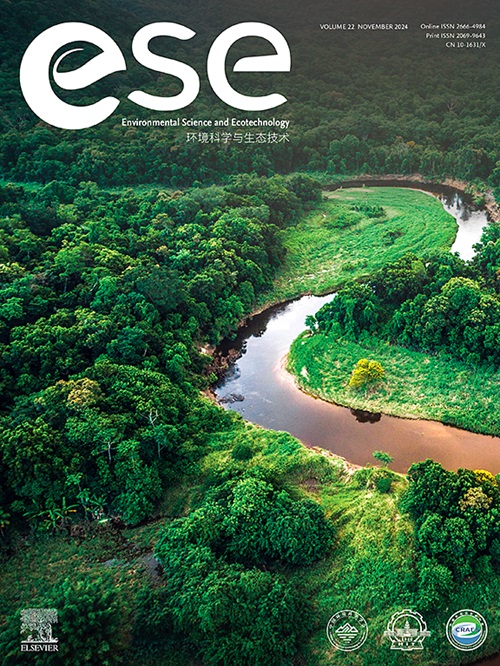通过数据驱动的逆设计加速生物电脱氯
IF 14.3
1区 环境科学与生态学
Q1 ENVIRONMENTAL SCIENCES
引用次数: 0
摘要
微生物电呼吸利用细菌驱动还原性脱氯,为修复被持久性氯化有机污染物(cop)污染的环境提供了一种可持续的方法。然而,含水层复杂的水文地质和水化学条件,加上COP分布不均匀,造成了生物化学反应、环境因子和微生物群落的巨大时空变异。传统的试错实验是劳动密集型和缓慢的,阻碍了快速确定加速脱氯速率的条件。在这里,我们展示了一个机器学习框架,将实验设计与阴极生物膜数据相结合,揭示了环境变量、脱氯动力学、电化学性质和功能微生物之间的关键相互关系,从而实现了生物电脱氯的快速优化。使用极端梯度增强、随机森林和多层感知器等模型对文献数据集进行训练,该框架将温度和阴极电位确定为实验设计的主要驱动因素,同时突出了关键的生物膜属,包括Clostridium、Desulfovibrio、Dehalococcoides、Pseudomonas、Dehalobacter、Arcobacter、Lactococcus和Geobacter。它支持逆向设计,以确定最佳参数,如阴极电位、温度和添加剂,用于脱氯代表性cop,包括四氯乙烯、三氯乙烯和1,2-二氯乙烷,实现反应速率预测误差低于6%。该方法超越了传统方法,提高了效率,降低了成本,加速了生物修复,而无需大量的实验室测试。通过将微生物群落洞察纳入预测模型,我们的数据驱动策略推进了微生物电呼吸在二氧化碳污染水修复中的可扩展应用,并为环境工程中更广泛的生物电化学应用铺平了道路。本文章由计算机程序翻译,如有差异,请以英文原文为准。

Accelerating bioelectrodechlorination via data-driven inverse design
Microbial electrorespiration harnesses bacteria to drive reductive dechlorination, offering a sustainable method to remediate environments contaminated with persistent chlorinated organic pollutants (COPs). However, aquifers' complex hydrogeological and hydrochemical conditions, combined with uneven COP distribution, create substantial spatial and temporal variability in biochemical reactions, environmental factors, and microbial communities. Traditional trial-and-error experiments are labor-intensive and slow, impeding the quick identification of conditions that accelerate dechlorination rates. Here we show that a machine learning framework, integrating experimental design with cathodic biofilm data, uncovers key interrelationships among environmental variables, dechlorination kinetics, electrochemical properties, and functional microbes, enabling rapid optimization of bioelectrodechlorination. Trained on literature-derived datasets using models such as extreme gradient boosting, random forest, and multilayer perceptron, this framework identifies temperature and cathode potential as primary drivers in experimental design while highlighting key biofilm genera, including Clostridium, Desulfovibrio, Dehalococcoides, Pseudomonas, Dehalobacter, Arcobacter, Lactococcus, and Geobacter. It supports inverse design to determine optimal parameters—such as cathode potential, temperature, and additives—for dechlorinating representative COPs, including tetrachloroethene, trichloroethene, and 1,2-dichloroethane, achieving reaction rate predictions with errors below 6 %. This approach surpasses conventional methods by increasing efficiency, cutting costs, and accelerating bioremediation without extensive laboratory testing. By incorporating microbial community insights into predictive models, our data-driven strategy advances the scalable application of microbial electrorespiration for COP-contaminated water remediation and paves the way for broader bioelectrochemical uses in environmental engineering.
求助全文
通过发布文献求助,成功后即可免费获取论文全文。
去求助
来源期刊

Environmental Science and Ecotechnology
Multiple-
CiteScore
20.40
自引率
6.30%
发文量
11
审稿时长
18 days
期刊介绍:
Environmental Science & Ecotechnology (ESE) is an international, open-access journal publishing original research in environmental science, engineering, ecotechnology, and related fields. Authors publishing in ESE can immediately, permanently, and freely share their work. They have license options and retain copyright. Published by Elsevier, ESE is co-organized by the Chinese Society for Environmental Sciences, Harbin Institute of Technology, and the Chinese Research Academy of Environmental Sciences, under the supervision of the China Association for Science and Technology.
 求助内容:
求助内容: 应助结果提醒方式:
应助结果提醒方式:


